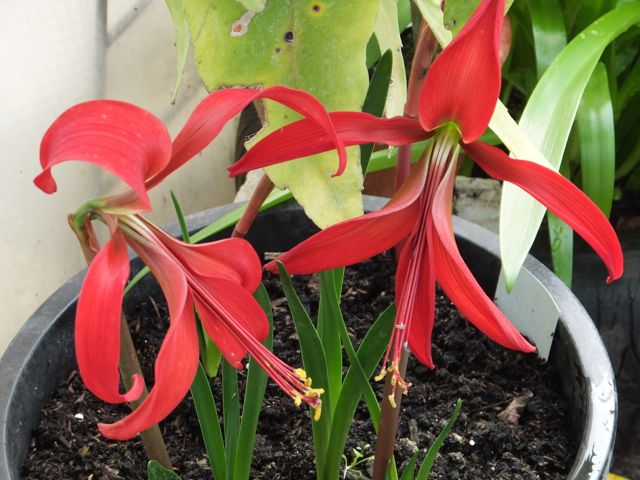
Any greenhouse, conservatory or sunny windowsill will be graced by the tropical beauty and perfection of a pot of Jacobean lilies.
The flowers are relatively huge reaching saucer or side-plate size and a foot or so high, in richest crimson lightly marked with gold, these first appear in early summer then again through summer. Sprekelia formosissima, one of the Amaryllis family have been delighting flower lovers in Europe since they were introduced in 1568. Despite their name these come from Mexico and Central America not from Formosa; formosissima is Latin for perfectly formed, handsome or beautiful. The Sprekelia bit is after a horticulturist Lawyer from Hamburg, a friend of Linnaeus believed to introduce it to him for Linnaeus noted this flower exudes a drop of nectar each morning.
The English name of Jacobean lily is often thought to refer to that period when these were first popular and the King James were on the throne, apparently though the name originated with St James and probably as these may bloom on his saint’s day the 25th July. Despite their exotic almost orchid-like appearance and apparent delicacy Sprekelia are actually fairly robust easy subjects providing they can be kept frost free, some even flourish outdoors in sheltered spots in the southwest UK. Anyway greenhouse culture is safer and as the tops die down in autumn the bulbs, just left in their dried out compost in their tubs, can be stored in the dry through winter before reviving again in spring. During the growing season they like a bright sunny position (though not requiring much heat) and plenty of ventilation. The elegant but a tad brittle leaves follow the first flowers and reach up to two foot long so the plants should be positioned somewhere these will not be knocked against.
Although you might try and start from seed if you could obtain this it’s quicker and simpler to buy bulbs. Sprekelia bulbs resemble big tulips with a blackish ‘coat’ and are of flowering size at a couple of inches in diameter. These prefer to be buried with their tip just showing in a sandy, free draining, leaf mould rich, compost. Generous pots help keep up the flowering for though one bulb will initially perform in a small pot it can not keep on doing so, I recommend three or five bulbs to a small-bucket sized tub. Their compost needs to be kept moist all growing season and then dried off in autumn. During the early months, and especially as the flowers expand, add a nitrogenous liquid feed weekly to ensure regular flowering now and for future years. Generally Sprekelias are remarkably trouble free but they do require re-potting every three or four years to separate the extra bulbs that have multiplied and which if left would congest the parents.
When you fall for these beauties then you may also look for rare strains such as Karinski with white edged flowers and ringens where the flowers have a yellow mark on the upper petals as well as the golden anthers and spots.


